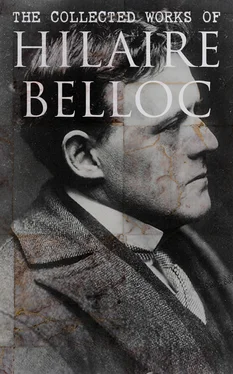Mouveaux thus carried, the head of York’s column was on a line with the head of Otto’s, which held Tourcoing just two miles away. The heads of either column now occupied the main road between Lille and Courtrai (which passes through Mouveaux and Tourcoing), and the heads of either column also held the slight crests from which the belated advance of Clerfayt from the Lys could be watched and awaited.
But though there was evidence of heavy fighting down in the river valley five miles to the north and west, and though it seemed probable from the sound of the firing that Clerfayt with the sixth body had crossed the Lys at Wervicq and was now on the right side of it, upon the southern bank, there was no sign of his advancing columns in those empty fields towards Linselles and the river over which the setting sun glared.
Neither, as his troops prepared to bivouac for the night upon the slopes of Mouveaux, could York, looking southward, find any indication of the fourth and fifth columns under Kinsky and the Arch-Duke which should have come up to this same position at Mouveaux by noon seven hours before. The flat and marshy fields upon either bank of the Marque were anxiously scanned in vain as the twilight deepened. Down there, far off, the cannon had been heard all that afternoon round the French camp at Sainghin, but nothing had come through.
It was therefore under a sense of isolation and of confusion, with the knowledge that their left flank was open, that Clerfayt in front of them was not yet in reach, that the second and third columns, which had so thoroughly accomplished their task, established their posts under the early summer night to await the chances of the morning.
III
THE FOURTH AND FIFTH COLUMNS UNDER KINSKY AND THE ARCH-DUKE CHARLES
Now what had happened to the fourth and fifth columns under Kinsky and the Arch-Duke? I must describe their fortunes, show why they had failed to come up, and thus complete the picture of the general advance from the Scheldt, before I turn to conclude the explanation of the disaster by detailing the further adventures of Clerfayt after he had crossed the Lys.
(A) The Fourth Column under Kinsky
Kinsky with his 11,000 men had been delayed, as we have seen, at Froidmont by the message which the Arch-Duke had sent him from St. Amand, to the effect that the fifth column could not hope to be at Pont-à-Marcq before dawn upon the 17th.
At the moment, therefore, when in the small hours of Saturday the 17th Otto and the Duke of York started out simultaneously from Bailleul and Templeuve, Kinsky was still pinned to Froidmont. But he knew that the Arch-Duke had started with his great column some time after dark in the Friday night from St. Amand, and when he estimated that they had proceeded far enough along the road to Pont-à-Marcq to be up level with him upon his left, Kinsky set his men in march and made for the Bridge of Bouvines, which was the crossing of the Marque immediately in front of him.
The Bridge of Bouvines lay right in front of the great French camp. It was strongly held, and the hither side of the river, as Kinsky approached it, was found to be entrenched. His men drove the French from those entrenchments, they retired over the bridge, and as they retired they broke it down. Upon the far side of the river in front of their camp the French further established a battery of heavy guns upon that slight slope which is now crowned by the Fort of Sainghin, and Kinsky could not force the passage until the fifth column, or at any rate the head of it, should begin to appear upon his left.
It will be seen upon the frontispiece map that when the Arch-Duke’s men reached Pont-à-Marcq and crossed the river there, they would take the French camp and the main French forces there in reserve, weaken the power of the French resistance at the Bridge of Bouvines, afford Kinsky the opportunity of crossing at that point, and that, immediately after that crossing, Kinsky and the Arch-Duke, having joined hands, would be in sufficient strength to push back the French from Sainghin and to march up north together towards Mouveaux. The appearance of their combined force at Mouveaux by noon would fulfil the time-table, and at mid-day of Saturday, if the time-table were thus fulfilled, the whole combined force of the second, third, fourth, and fifth columns would have been astraddle of the Lille-Courtrai Road, would have cut off Souham’s corps from Lille, and could await Clerfayt if he had not yet arrived. When, therefore, the Arch-Duke and the fifth column should have crossed the Marque at Pont-à-Marcq, the fortunes of the fourth column would have blended with it, and the story of the two would have been one. We may therefore leave Kinsky still waiting anxiously in front of the broken bridge at Bouvines for news of the Arch-Duke, and conclude the picture of the whole advance from the Scheldt by describing what had happened and was happening to that Commander and his great force of 17,000 to 18,000 men.
(B) The Fifth Column under the Arch-Duke Charles
When the Arch-Duke Charles had let Kinsky know upon the day before, the Friday, that he could not be at the appointed post of Pont-à-Marcq by the next daybreak, he had implied that somewhere in the early morning of that Saturday, at least, he would be there. Exactly how early neither he nor Kinsky could tell. His troops had sixteen full miles to march; they had but one road by which to advance, and they were fatigued with the enormous exertion of that hurried march northward to St. Amand, which has already been set down.
Such were the delays at St. Amand in preparing that advance, that the night was far gone before the fifth column took the road to Pont-à-Marcq, and the effort that was to be demanded of it was more than should have been justly demanded of any troops. Indeed, the idea that a body of this great size, tied to one road, could suffer the severe effort of the rush from the south to St. Amand, followed by a night-march, that march to be followed by heavy fighting during the ensuing morning and a further advance of eight or nine miles during the forenoon, was one of the weakest points in the plan of the allies. No such weakness would have been apparent if the main body of the Austrians under the Arch-Duke had been called up on the 12th instead of the 14th, and had been given two more days in which to cover the great distance. But, as it was, the delay of the Emperor and his staff in calling up that main body had gravely weakened its effective power.
The league-long column thrust up the road through the darkness hour upon hour, with its confusion of vehicles and that difficulty in marshalling all units which is the necessary handicap of an advance in the darkness. Long before their task was so much as half accomplished, it was apparent not only that Pont-à-Marcq would not be reached at dawn, but that the mass of the infantry would not be at that river-crossing until the morning was far spent.
When day broke, though cavalry had been set forward at greater speed, the heads of the infantry column were but under the Hill of Beuvry. It was long after six before the force had passed through Orchies, and though Kinsky learnt, in the neighbourhood of eight o’clock, that the cavalry of the fifth column were up on a level with him and had reached the river, the main force of the fifth column was not available for crossing Pont-à-Marcq until noon, and past noon.
Kinsky, thus tied to the broken Bridge of Bouvines until Pont-à-Marcq should be forced, saw mid-day come and pass, and still his force and that of the Arch-Duke upon his left were upon the wrong side of the stream.
Yet another hour went by. His fourth column and the fifth should already have been nine miles up north, by Mouveaux, and they were not yet even across the Marque!
It was not until two o’clock that the passage of the river at Pont-à-Marcq was forced by the Arch-Duke Charles, and that, as the consequence of that passage of the stream, the French were taken in reverse in their camp at Sainghin and were compelled to fall back northward, leaving the passage at Bouvines free. Kinsky repaired the bridge, and was free to bring his 11,000 over, and the two extreme columns, the fourth and the fifth, would then have joined forces in the mid-afternoon of the Saturday, having accomplished their object of forcing the Marque and uniting for the common advance northward in support of Otto and the Duke of York.
Читать дальше












